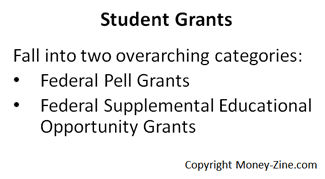Student grants are an important source of college funding, and their best feature is they don't have to be repaid. We're not talking about grant programs to conduct research. In this article, we are focusing on programs that help college and university students pay for the cost of their education.
Types of Student Grants
There are basically two types of federal student grant programs that we'll shortly discuss in more detail. The first is Pell Grants, which are awarded based on financial need. The second is the Federal Supplemental Opportunity Grant (FSEOG), which is awarded to students demonstrating exceptional need.
Qualifying for Student Grants
Additional Resources |
To qualify for a student grant, families need to fill out a Free Application for Federal Student Aid (FAFSA). Once the application has been reviewed, a Student Aid Report (SAR) will be received, which will outline the Expected Family Contribution, or EFC. Congress has established a formula to determine who is eligible for student grants. The formula used to determine eligibility considers cost of attendance at a particular college or university, and the student's status as a full-time or part-time student.
Federal Pell Grants
In general, Federal Pell Grants are awarded only to undergraduate students. There are exceptions, and some graduate students enrolled in a teacher certificate program may also be eligible. The 2020 / 2021 maximum grant under the Pell program is $6,345.

Pell Grants are paid out by a college or university at least once per term. The grant can be paid to a student's account, directly to the student, or using a combination of these methods. The school must notify the student in writing about the process, and this letter will include how much is being paid, where the money will be deposited, and how frequently those deposits will be made.
Federal Supplemental Educational Opportunity Grants
Federal Supplemental Educational Opportunity Grants, or FSEOG, is a program reserved for students demonstrating exceptional financial need. Once again, this grant is targeted to undergraduate students, and eligibility is determined by ranking the lowest EFC. Priority is also given first to those students that are already eligible for Pell Grants. Like all grant programs, this money does not have to be repaid.
Grant Funding
Each school will receive from the federal government enough money to pay for their student's Pell Grants. Students that qualify for FSEOGs might not receive these grants. Students are awarded this money based on the funding level at the school. That is how the priority is used; those students with the lowest EFC will get these grants first, until the funding is depleted. The exact amount of these grants will vary between $100 and $4,000, depending on when the student applies, demonstrated need, and funding levels. Policies may also vary from school to school, so students need to check with their financial aid office. As was the situation with Pell Grants, money is dispersed to a school account, the student's bank account, or a combination of these methods. These grants are paid to each student at least once per term.
Other Types of Federal Grants
At the beginning of this article, we discussed student grants versus other types of federal grants. To qualify for a grant, the recipient must first apply for the award directly with the federal agency responsible for administering the program. That agency then determines if the award will be paid, and how large the grant will be. When receiving an award, the recipient usually agrees to certain terms and conditions. This may also include rules and regulations of the program itself or the federal agency. Failure to follow the terms and conditions of the grant can result in its loss and even fines. In general, there are five different types of grants:
Project Grants
A project grant is awarded on a competitive basis. That is, there are many potential recipients competing for project grants. Most of these grants involve scientific research, social services, the arts, advanced technologies, and higher education. Pell and FFEOG grants are considered project grants.
Formula Grants
A formula grant provides funding that is based on a law. Examples of formula grants include the Work Incentive Program and the Job Training Partnership Act. Formula grants can also be broken down further into two subcategories: categorical, and block.
Categorical Grants
A categorical grant can only be spent for a narrowly-defined reason. Recipients of categorical grants are usually asked to match a portion of the money provided. Most of the categorical grants in existence today are also considered formula grants. Examples include Urban Forestry Assistance and the Head Start program.
Block Grants
Block grants are generally less restrictive in terms of how the money is used relative to categorical grants. This flexibility is demonstrated by the programs benefiting from this type of federal aid. Typical programs include drug and alcohol abuse, community efforts, and mental health services.
Earmark Grants
Earmark grants are federal grants that have been singled-out by appropriations of the U.S. Congress. Perhaps the most controversial of all grant programs, the process itself is open to abuse by lobbyist and politicians alike. In 2010, earmark grants accounted for nearly $43 billion in federal spending.
About the Author - Student Grants



.jpg)
.jpg)